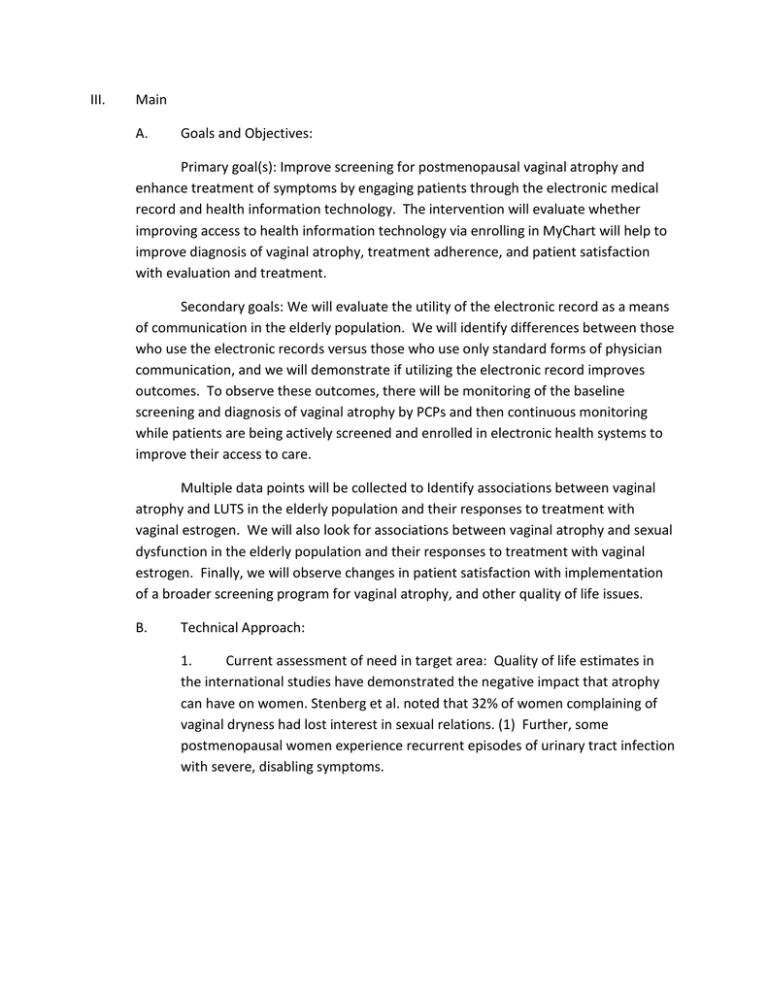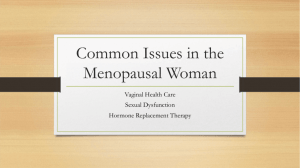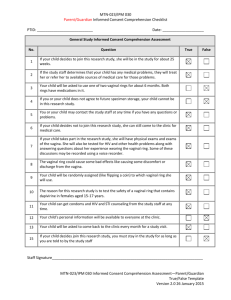III. Main A. Goals and Objectives: Primary goal(s)
advertisement

III. Main A. Goals and Objectives: Primary goal(s): Improve screening for postmenopausal vaginal atrophy and enhance treatment of symptoms by engaging patients through the electronic medical record and health information technology. The intervention will evaluate whether improving access to health information technology via enrolling in MyChart will help to improve diagnosis of vaginal atrophy, treatment adherence, and patient satisfaction with evaluation and treatment. Secondary goals: We will evaluate the utility of the electronic record as a means of communication in the elderly population. We will identify differences between those who use the electronic records versus those who use only standard forms of physician communication, and we will demonstrate if utilizing the electronic record improves outcomes. To observe these outcomes, there will be monitoring of the baseline screening and diagnosis of vaginal atrophy by PCPs and then continuous monitoring while patients are being actively screened and enrolled in electronic health systems to improve their access to care. Multiple data points will be collected to Identify associations between vaginal atrophy and LUTS in the elderly population and their responses to treatment with vaginal estrogen. We will also look for associations between vaginal atrophy and sexual dysfunction in the elderly population and their responses to treatment with vaginal estrogen. Finally, we will observe changes in patient satisfaction with implementation of a broader screening program for vaginal atrophy, and other quality of life issues. B. Technical Approach: 1. Current assessment of need in target area: Quality of life estimates in the international studies have demonstrated the negative impact that atrophy can have on women. Stenberg et al. noted that 32% of women complaining of vaginal dryness had lost interest in sexual relations. (1) Further, some postmenopausal women experience recurrent episodes of urinary tract infection with severe, disabling symptoms. Despite a general knowledge of the condition, primary care physicians often have too many other problems and concerns to address to make a stong effort at sexual and vaginal health screening in routine visits. As the RFP states, there is often a lack of time for menopause discussions during office visits, particularly for PCPs who often must address a number of chronic conditions in a limited time period. The menopause discussion can be awkward for many providers and patients. Some patients may arrive to these discussions with negative preconceptions and fears about hormone therapy. From the recently published Vaginal Health: Insights, Views & Attitudes (VIVA) survey study, half of respondents had experienced vaginal discomfort since they had stopped menstruating, most commonly (88%) vaginal dryness; over half (56%) reported having experienced symptoms for three years or longer. 82% of women felt that vaginal discomfort would have a negative impact on various aspects of their lives, most notably sexual intimacy (72%), ‘having a loving relationship with a partner’ (39%) and ‘overall quality of life’ (30%). (2). While practicing clinically, our staff has noted a low rate of diagnosis for postmenopausal vaginal atrophy. The Explorys database was queried to examine the number actual of patients with the diagnosis of vaginal atrophy throughout our medical center. Investigation into the diagnosis rate at our institution confirmed our low rate. In the population of female patients ages 50 and over, 1026 of the >196,000 women have the diagnosis of vaginal atrophy, giving us a diagnosis rate of only 0.5%. While the worldwide prevalence of vaginal atrophy symptoms is often underestimated, ranging from 27-55% of women (1,3-4), our rate of diagnosis, and thus treatment, is far too low. The New England Journal of Medicine study by Cebul et al. from our institution and Center for Healthcare Research and Policy cited a significantly higher achievement of care and better outcome standards in sites that effectively use the electronic health record. (5) Recent advances in the health information technology and electronic medical record capabilities at our institution have prompted us to look for new ways to reach out to patients and improve communication. The MyChart application through the EPIC-based electronic medical record and the Internet allows physicians and patients to communicate in a confidential, interactive format. Questions can be answered, results given, and open lines of communication can be established. Increasing effective physician-patient communication helps to improve outcomes. (6) All patients seen in the outpatient clinics over the last year have been given instructions on accessing and enrolling in the MyChart program on the standard after-visit paperwork. Upon review of EPIC utilization data, our current rate of MyChart enrollment for women over age 50 is 29%. There are 8171 MyChart females ages 50-105 out of the total 28015 MyChart patients. The un-enrolled rate of 71% in the over 50 population is high, despite these older patients having a large burden of medical issues and greater need for interaction with their physicians. In addition to improving outcomes, communication improves the patient experience. One large review study indicates consistent positive associations between patient experience, patient safety and clinical effectiveness for a wide range of disease areas, settings, outcome measures and study designs. There is an ongoing effort at all institutions nationally to improve the patient experience and overall quality of care. This intervention will serve to enhance the screening for and increase the diagnosis of post-menopausal vaginal atrophy in the population of women over age 50 at our institution. The intervention will also evaluate whether improving access to health information technology via enrolling in MyChart will help to improve diagnosis, treatment adherence, and patient satisfaction. 2. Intervention Design and Methods: This is a prospective, randomized study of vaginal atrophy screening and EMR usage. The intervention is designed to assess multiple aspects of patient care from screening, to treatment, to outcomes, to satisfaction, to compliance and informatics utilization. The patient population is all women in a primary care setting over age 50. Those who subscribe to MyChart EMR access will be randomized to either a vaginal atrophy screening or a placebo screening. Randomization schemes will be set up by the consulting statistician prior to study initiation. This randomization and controlled placebo group will allow us to observe whether the act of screening via MyChart increases health discussions and increases the diagnosis of vaginal atrophy, or if directed screening for vaginal atrophy is necessary to increase the diagnosis and treatment rate. A third arm of patients will be those women over 50 who are not MyChart subscribers. Those women will be randomized to either paper questionnaires with standard MyChart instructions or Enrollment in MyChart and completion of electronic questionnaires with direction from research staff. All patients will have access to standard of care treatments by their PCPs and also access to referrals as indicated and desired. See the flow diagram below. Recruitment for new enrollees will take place for 1 year, and follow up questionnaire data will be collected at 6 months. Once enrolled in the study, data will be collected regarding patient demographics and baseline EMR utilization. Baseline vaginal atrophy symptoms will be obtained from their questionnaires. All paper questionnaire data will be uploaded into electronic format so that PCPs will not know who was paper or electronic format. Those who are screened for vaginal atrophy will be “flagged” in the EMR at their outpatient visits by their PCPs. EPIC flags will alert those PCPs to the positive screening status and the potential for vaginal atrophy in that patient. For those in the placebo questionnaire group, their diagnosis and treatments will also be recorded. All patients who were previously enrolled or newly enrolled in MyChart will have their MyChart utilization monitored before and after screening in this study. EPIC and My Chart utilization data will be collected and used to determine if screening helps to increase utilization. The diagnosis of vaginal atrophy will be recorded after screening, and any treatments will be recorded to evaluate how this varies when compared to our current practices. The questionnaires administered at 6 months after screening will help to determine if screening improved diagnosis rate, treatment rate, symptoms, and overall perception satisfaction with the quality of care. 6 Month data will also assess willingness to continue with current treatments and overall impressions of improvement. 3. Evaluation Design: Throughout enrollment and until completion of the study data collection period, all data will be stored securely in the RedCAP online data management system. From there, de-identified analytic data sets will then be able to be exported to a statistical analysis package for further examination by a biostatistician. Statistical models will be developed and data will be analyzed to see changes in diagnosis rates of vaginal atrophy amongst groups. The placebo control group will be compared to the atrophy screening group to determine if the act of screening starts a discussion that could influence the diagnosis of atrophy, or if only the atrophy screened patients had increase in diagnosis rate. We would hope to see a 25% increase in diagnosis rate, an increase that would make our diagnosis rate more consistent with the prevalence of the condition of vaginal atrophy. We would expect that there would be some effect of the placebo, so the number needed in each randomized arm to see a difference in proportions between these groups with an 80% power to detect a 15% difference would be 100, with an alpha error of 0.05. The second comparison will be made in the atrophy screened groups to see if electronic users were diagnosed and treated more than the paper users, and if those who were prior MyChart users were diagnosed with vaginal atrophy more than newly or non-enrolled patients. We will also compare rates of EPIC and MyChart utilization between all groups to see how rates change after a screening program of any sort, and this will help determine how establishing communication can enhance access to treatments. After full analysis of all data, multiple outlets for presentation of our findings will be available. Given the multi-disciplinary nature of the project, we expect presentation and publication of result of the different analyses in the gyn, geriatric, quality, and informatics societies and literature venues. The coinvestigators involved in this study are all well-regarded in their field and will present the data and findings at both regional and national meetings of their societies. Areas of future research and avenues for funding will be pursued based on these results. C. Detailed Workplan: After grant funding is approved, the research project manager will assign a full time coordinator to this initiative. This research staff will submit the proposal and protocol to the IRB for review. This submission, review, and approval process takes up to 3 months. While waiting for IRB approval, MyChart and EPIC applications will be edited with the aid of Information Services (IS). Programming will be made ready so that once IRB approved, the questionnaires and screening process can begin. Research staff will be allocated to the study with the equivalent of 1.0 FTE research coordinator. This person will have the background and ability to interact with patients for consent and data collection. Also in anticipation of study IRB approval, IS will help with setup of computer workstations in private areas of the SHOP for questionnaire completion and also for study staff workspace. 2 new workstations are requested for completion of this study. These workstations will remain in place for future educational programs for seniors and future screening studies. Faculty at the SHOP and the Internal Medicine clinic will have educational sessions regarding the management and treatment options for post-menopausal vaginal atrophy, and they will be introduced to the aims of this study. Once the study is IRB approved and staff in place, patients will be screened with validated questionnaires using the MyChart application and Internet communication for consent. All women over age 50 who are enrolled in MyChart will be sent an invitation to participate in our screening study. Once consented, the patients will be randomized into 1 of 2 arms, either a vaginal atrophy screening group or a sleep apnea screening group, which will be used as a placebo group. The questionnaires will then be sent to the patient using MyChart and results will be monitored and recorded. EPIC programmers will be available for creation and administration of this process. Those who screen positive for vaginal atrophy or sleep apnea will have appropriate treatment or referrals as indicated and desired. To complete a second aim of the initiative, the research coordinator stationed at the Senior Health Outpatient (SHOP) facility will work to enroll patients who are not already MyChart users. This will serve two functions, to increase MyChart enrollment numbers and also to increase participation in the screening questionnaire portion of the study. This site is used to focus our efforts in screening only postmenopausal women. One must be over age 50 to have an appointment at the SHOP. There were over 3,092 women seen at that facility in 2012 with an average age of 65 years, so adequate numbers of study patients utilizing only that center will be readily available. Patients will be screened prior to their scheduled appointments. If the patient wishes to participate in the study, then questionnaires will be offered via multiple routes in a randomized fashion. Those who were not yet enrolled in MyChart will be randomized to an arm that will get assistance with enrolling in MyChart and using the application to complete the screening. The other arm of this randomization will complete the questionnaires on paper and will then receive only the standard after-visit instructions for enrollment in MyChart. Those who decline participation will be recorded so that they will not be re-approached for participation. Those who decline will also be used as a control group to assess the rate of diagnosis of vaginal atrophy and rate of MyChart utilization in the unscreened population. After the screening process, data from the questionnaires will be made available to the PCP’s. If patients are noted to screen positive for vaginal atrophy symptoms, then treatment can be offered as indicated and desired by the patient. Note will be made if treatment or consultation is offered and then declined. Record of diagnoses and treatments/referrals will also be kept for the placebo group that screened with alternate questionnaires. Patients will then undergo treatment or no treatment, as they desire, for their symptoms. At 6 months after their initial screening visit, questionnaires will again be administered. After each patient’s 6 month data is collected, the study participation is complete. Rate of diagnosis, rate of treatment, rate of MyChart enrollment and utilization, and satisfaction with treatment/no treatment will be recorded for comparison between the multiple randomized groups. In addition to the above data collection, baseline demographics will be monitored. Screening and enrollment in the study will be ongoing for a period of 12 months, with 6 months of continued data collection following closure of enrollment. An additional 3 months will be used following completion of the data collection for statistical review and synthesis of the data. Given the multiple arms of randomization and both clinical and informatic nature of this initiative, our goal would then be to present it widely at multiple subspecialty meetings and publish at least 2 separate manuscripts with the data in the literature. D. Deliverables Schedule IRB submission/approval 9/2013 MyChart/EPIC applications ready and able to use 9/2013 RedCAP database setup 9/2013 Hold education sessions for PCP’s on vaginal atrophy 2 sessions, 9/2013 Complete enrollment at 12 mos 9/2014 Complete data collection at 18 mos 4/2015 Data analysis complete 5/2015 Abstract prepared/presented 6/2015 Manuscript written 7/2015 References 1. Stenberg A, Heimer G, Ulmsten U, Cnattingus S. Prevalence of genitourinary and other climacteric symptoms in 61-year-old women. Maturitas 1996;24:31–6. 2. Frank SM, Ziegler C, Kokot-Kierepa M, et al., Vaginal Health: Insights, Views & Attitudes (VIVA) survey - Canadian cohort, Menopause International 2012: 1–8. DOI: 10.1258/mi.2012.012034 3. Van Geelen JM, van de Weijer PH, Arnolds HT.Urogenital symptoms and resulting discomfort in non-institutionalized Dutch women aged 50–75 years. Int Urogynecol J Pelvic Floor Dysfunct 2000;11:9–14. 4. Utian WH,Schiff I. North American Menopause Society-Gallup Survey on women’s knowledge, information sources, and attitudes to menopause and HRT. Menopause 1994;1:39–48. 5. Cebul, Randall D., et al. "Electronic health records and quality of diabetes care." New England Journal of Medicine 365.9 (2011): 825-833. 6. Stewart MA, Effective physician-patient communication and health outcomes: a review. CMAJ May 1, 1995 152:1423-1433



